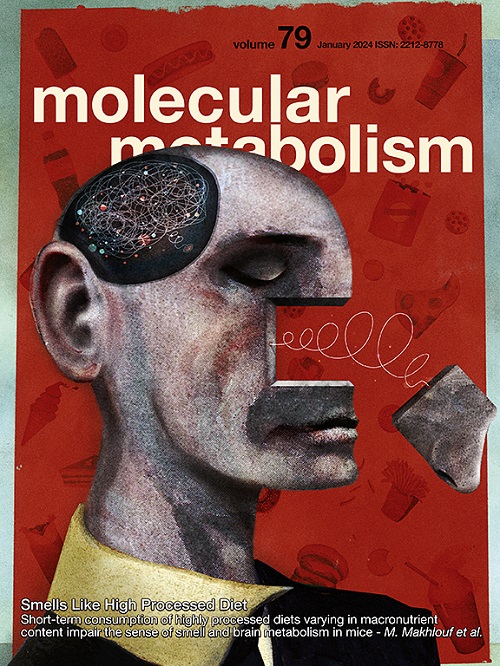胰高血糖素样肽-2药物治疗激活肝Farnesoid X受体信号,以减轻小鼠切除相关胆汁酸损失。
IF 7
2区 医学
Q1 ENDOCRINOLOGY & METABOLISM
引用次数: 0
摘要
胰高血糖素样肽-2 (GLP-2)类似物teduglutide在临床上用于治疗广泛肠切除术后发生的短肠综合征和肠衰竭。最近发现GLP-2治疗的作用是抑制胆囊运动和增加胆囊充盈。然而,这两种glp -2特征对健康和肠切除术后胆汁酸代谢的影响尚未得到很好的表征。为了研究teduglutide治疗的效果,我们将硒-75-同胆酸牛磺酸(SeHCAT)测定与健康小鼠和回盲切除后(ICR)小鼠的新型空间成像相结合,并将结果与临床阶段靶向胆汁酸代谢组学和基因表达分析相关联。ICR小鼠的肠道次级胆汁酸几乎完全丧失,12α-羟基化胆汁酸与非12α-羟基化胆汁酸的比例增加,这种比例被丁肽类药物减弱。Teduglutide促进了健康小鼠和ICR小鼠中SeHCAT的保留。观察到sehcat信号进入肝胆系统的急性浓度。Teduglutide诱导肝脏cyp8b1表达显著抑制,这与MAF BZIP转录因子g的诱导有关。数据表明,glp -2药物治疗主要通过肝Farnesoid X受体信号传导显著减缓小鼠胆汁酸循环。本文章由计算机程序翻译,如有差异,请以英文原文为准。
Glucagon-like peptide-2 pharmacotherapy activates hepatic Farnesoid X receptor-signaling to attenuate resection-associated bile acid loss in mice
Objective
Villus growth in the small bowel by Glucagon-like peptide-2 (GLP-2) pharmacotherapy improves intestinal absorption capacity and is now used clinically for the treatment of short bowel syndrome and intestinal failure occurring after extensive intestinal resection. Another recently acknowledged effect of GLP-2 treatment is the inhibition of gallbladder motility and increased gallbladder refilling. However, the impact of these two GLP-2-characteristic effects on bile acid metabolism in health and after intestinal resection is not understood.
Methods
Mice were injected with the GLP-2-analogue teduglutide or vehicle. We combined the selenium-75-homocholic acid taurine (SeHCAT) assay with novel spatial imaging in healthy mice and after ileocecal resection (ICR mice) and associated the results with clinical stage targeted bile acid metabolomics as well as gene expression analyses.
Results
ICR mice had virtual complete intestinal loss of secondary bile acids, and an increased ratio of 12α-hydroxylated vs. non-12α-hydroxylated bile acids, which was attenuated by teduglutide. Teduglutide promoted SeHCAT retention in healthy and in ICR mice. Acute concentration of the SeHCAT-signal into the hepatobiliary system was observed. Teduglutide induced significant repression of hepatic cyp8b1 expression, likely by induction of MAF BZIP Transcription Factor G.
Conclusions
The data suggest that GLP-2-pharmacotherapy in mice significantly slows bile acid circulation primarily via hepatic Farnesoid X receptor-signaling.
求助全文
通过发布文献求助,成功后即可免费获取论文全文。
去求助
来源期刊

Molecular Metabolism
ENDOCRINOLOGY & METABOLISM-
CiteScore
14.50
自引率
2.50%
发文量
219
审稿时长
43 days
期刊介绍:
Molecular Metabolism is a leading journal dedicated to sharing groundbreaking discoveries in the field of energy homeostasis and the underlying factors of metabolic disorders. These disorders include obesity, diabetes, cardiovascular disease, and cancer. Our journal focuses on publishing research driven by hypotheses and conducted to the highest standards, aiming to provide a mechanistic understanding of energy homeostasis-related behavior, physiology, and dysfunction.
We promote interdisciplinary science, covering a broad range of approaches from molecules to humans throughout the lifespan. Our goal is to contribute to transformative research in metabolism, which has the potential to revolutionize the field. By enabling progress in the prognosis, prevention, and ultimately the cure of metabolic disorders and their long-term complications, our journal seeks to better the future of health and well-being.
 求助内容:
求助内容: 应助结果提醒方式:
应助结果提醒方式:


